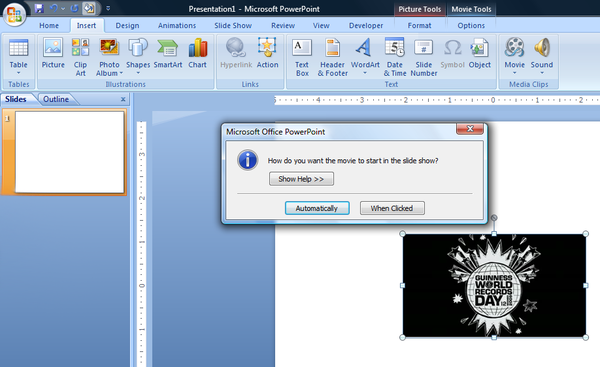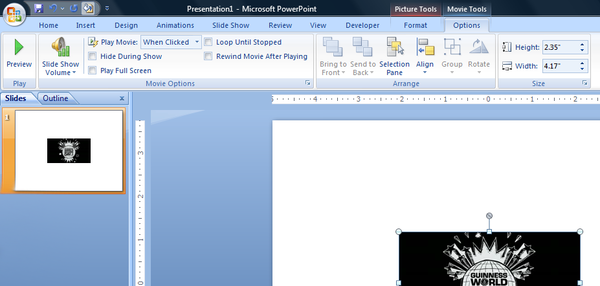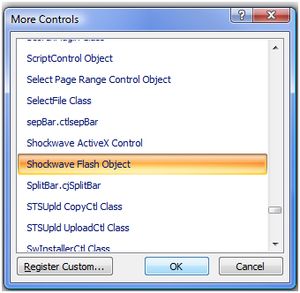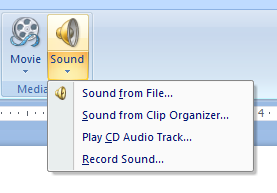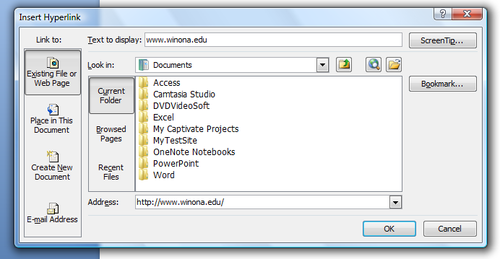PowerPoint (PC)/Adding Video and Sound
Videos and audio files can be "embedded" in PowerPoint slides.
In this way you can show short movie clips or listen to sound files as an accent to your presentation or as a major feature of it.
- Play a scene from a movie
- Illustrate a point
- Let the author speak for him or herself
When embedded, the files can be set to automatically start when the slide appears or at the interval you want.
Alternatively, video and sound can be hyperlinked to your slide and can be played by streaming the media from the internet. But embedded files have the advantage of not requiring a internet connection and avoid annoying load-delays for streaming, and will keep your presentation active, instead of switching to another application such as an internet browser.
You should be careful to understand, however, copyright restrictions, and how they apply to your usage. Only videos and sound files that you personally created or whose copies you own, or which are otherwise permitted for Fair Use in classrooms should be embedded in your PowerPoint. Generally, you should avoid public performance, publication or broadcast of these files. But in most cases limited classroom use should be no problem.
Basic Copyright Rules
Under Copyright laws Instructors and students are permitted a Fair Use of video and sound from commercial sources, movies, TV shows, etc. which are not otherwise free of royalties.
Current guidelines by Minnesota State for use of copyrighted materials INSIDE classrooms allows a good deal of latitude:
- "The Minnesota State Colleges and Universities Office of the Chancellor has established the following guidelines relating to the performance of copyrighted works in the classroom, distance education and in public settings, for educational purposes based on copyright law, including the recently enacted TEACH Act."
- "Educators at Minnesota State Colleges and Universities colleges and universities may show, display or perform others' work in the classroom, including videos, motion pictures, other similar audiovisual works, music materials, dramatic works, and other copyrighted works under the following conditions:
- The showing or displaying of the work is done in the classroom or similar place devoted to instruction.
- The teacher and the students must be in the same location.
- The audience must be composed of members of one class only.
- The showing or displaying of the work must be part of systematic instruction, which does not include recreational or cultural programs.
- The showing or displaying of the work must be the decision of the instructor, a student, or a guest lecturer.
- In the case of videotape, film, or other audiovisual work, the work must have been lawfully obtained.
- Provided these conditions are met, few restrictions are placed on educators' use of others' work in a face-to-face classroom setting."
- "Educators at Minnesota State Colleges and Universities colleges and universities may show, display or perform others' work in the classroom, including videos, motion pictures, other similar audiovisual works, music materials, dramatic works, and other copyrighted works under the following conditions:
For more information about Minnesota State policy regarding the use of copyrighted materials, go to these Frequently Asked Questions (FAQ).
The reproduction or creative appropriation of content, not simply the playing of content for the sake of discussion or interpretation, has different considerations.
If you use content OUTSIDE classrooms, the use of audio/video loops or samples that are not royalty-free should be limited by Fair Use Standards: that is, segments should not exceed 10% or 30 seconds of copyright-protected recording.
NOTE: rules for use of copyrighted materials are complex. If you have additional questions, contact:
- Thomas Bremer
- Dean, Library & Information Services
- Somsen Hall 202B
- email Dr. Bremer
- (507) 457-5141
Embedding Videos
To embed a video to slide, click on the icon for movie in the slide.
Or use the menu Insert>Movie...
- NOTE: To edit videos for PowerPoint, see MovieMaker and related help.
A dialog will prompt you to locate the file in the usual way.
The common video files that can be used in Microsoft PowerPoint for a PC are those made for Microsoft Media Player (WMV) as well files that ordinarily work for a PC in such as AVI, or MPEG.
Flash (FLV) files will not work with PowerPoint on the PC.
After selection you will be prompted to decide whether you want the movie to start automatically (default) or on a click.
The movie will be centered and will appear on the slide as freeze frame. The movie image can be resized, using "handles" on the corners of the image to make it smaller or larger. Keep in mind that a larger size will probably be more blurry.
On the top of the menu, a special set of tools, under the tab "Move Tools," will become available when you select the movie object for the selected movie.
In the toolbar you can change several features of the movie's presentation, including:
- Timing of when it plays
- Change volume
- Change object size
- Toggle to show full screen
- Loop it
How to Download YouTube Videos or other FLV (Flash) Files
In the case of most YouTube content, there are no copyright restrictions to viewing.
Here are many different online services that will download YouTube and other video content to your computer. Here are just a few:
KeepVid<--probably the best bet!
You may use these services for YouTube, MetaCafe, Google Video and others. You generally need to copy and paste the URL for the video into a window. So you will need to access or choose the item first.
- These online resources usually permit you to save/convert your files to a file format you can use with PowerPoint on the PC (WMV, AVI, MP4).
- REMEMBER: files will need to be in one of these formats to work with PowerPoint on the PC.
Converting FLV for use in Powerpoint
There several utilities that can be used to convert files from FLV or MP4 to AVI which is the file format used by PowerPoint in the PC.
Go to CNET's Download.com for Freeware and Shareware files. Search for "MP4 to AVI Converter" or "FLV to AVI Converter." You will find many options. Some of the Shareware software requires purchase for full use and may come with serious limitations in the demonstration mode. Freeware software can be, on the other hand, a bit clumsy in design, not easy to use, and can be faulty.
Here are two freeware apps that are reliable, but you may find them a bit confusing to use. There is help documentation for them.
- For Converting between MP4 and AVI -- try this: Pazera MP4 to AVI Converter (Free)
- For Converting between FLV and AVI -- try this: Pazera FLV to AVI Converter (Free)
Embedding FLV (e.g., YouTube Video) without Conversion
Instructions
In PowerPoint 2007 - click on Main Logo ![]() up in the top left hand corner – go to PowerPoint Options > Popular > Show Developer Tab in Ribbon > Click on OK.
up in the top left hand corner – go to PowerPoint Options > Popular > Show Developer Tab in Ribbon > Click on OK.
- NOTE: This will only work if you are connected live to the Internet. If you are not connected live to the Internet while presenting you will get a blank screen.
In your PowerPoint presentation, on the appropriate slide, click where you want to embed the movie.
- 1. Click on Developer Tab in menu - >More Controls > Shockwave Flash Object> OK.
- 2. Drag out the box to the size you want the video to be. This can be resized and moved. Control Box looks like this:
- 3. In your Internet Browser find the video that you want to embed into your presentation. Copy the URL Code from the video you want to embed (Ctrl C).
- 4. In PowerPoint, right click on control box and choose Properties.
- 5. In the Properties Dialog Box you need to:
- Paste (Ctrl V) the URL Code into the MOVIE property field.
- Change the UTL code.
- Delete the words watch?
- Change the equal sign (=) to a forward slash (/)
- Do not change the Embed Movie field to True.
- You can change the LOOP options with True or False.
- 6. Click on the X in the top right of the Properties box. Video should now be viewable in the slide in presentation view.If you get the message “Embedding disabled by request” you will not be able to view this video in PowerPoint.
You can embed your video into other graphics to enhance the appearance.
Our Internal Help Pages for PowerPoint PC Include
- Microsoft PowerPoint (PC)
- Microsoft PowerPoint Inserting a YouTube Video (PC)
- PowerPoint (PC)/Using PowerPoint to Make Diagrams
- PowerPoint (PC)/Adding Video and Sound
Other Resources
For more help: Video Tutorial from andyrush.net
Embedding Sound Files
To embed a sound file, use the Tool bar menu item Insert>Sound ....
The dialog allows you to select files from a file, play one from a CD, or get a song from the Clip Organizer.
You can also chose to record a voice-over from this point as well--to add comment to your slide.
Select files in the customary way... locating files in the directory.
An object will be placed with a small sound icon on the screen.
Using the toolbar which appears above the menu when the icon/object is selected, you can modify the same kind of things you might with video:
- Timing of when it plays
- Change volume
- Loop it
Using Hyperlinks to Stream Media
Using a selected object of string of text, use the command on the menu Insert>Hyperlink to open a dialog box to properly input the specifications of the hyperlink.
The hyperlink will open the streaming media or other pages in the web browser which is the default for the computer.
During the slide show, the hyperlink will be active.
Clicking on it will launch the browser and start the streaming media.
- SPECIAL: At the end of the media, use keyboard short-cut ALT-TAB to get a pop-up menu of applications to choose available open applications. Choosing PowerPoint will return you to your slide show.
Other Resources
For help from Microsoft: Click Here!
